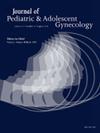4. GLP-2包被阴道扩张套(VES)对大鼠模型的影响
IF 1.7
4区 医学
Q3 OBSTETRICS & GYNECOLOGY
引用次数: 0
摘要
背景:阴道闭锁是先天性阴道缺失。目前的治疗方法包括家庭扩张治疗和手术阴道成形术。在我们之前的研究中,我们创造了一种新的阴道扩张套筒(VES),它只需要很小的手术干预就可以逐渐延长并保持阴道扩张。本研究旨在进一步探讨VES装置利用胰高血糖素样肽2 (Glucagon-like peptide 2, GLP-2)延长阴道的效果。已知GLP-2促进肠道组织增殖,但探索GLP-2在非肠道组织(包括女性生殖组织)中的作用的研究很少。方法超声心动图是一种圆柱形弹簧状装置,带有树脂盖。将每个VES切成当前阴道管长度的1.3倍,通过聚乙乙醇交联涂覆50µg GLP-2,插入4只Sprague Dawley大鼠的阴道管中,并用不可吸收缝线固定。每周,将套管取下,并在三周内更换为更长的VES,测量阴道管当前长度的1.3倍。对大鼠进行另外2周的监测,以评估阴道长度是否减少。阴道长度在初始VES插入前测量,在5周的试验中每周测量一次。结果:连续部署GLP-2涂层的VES装置可使阴道长度从26.25±0.96 mm增加到35.5±3.11 mm (p<;组织学上,可见弥漫性阴道壁变薄,保留了上皮、粘膜和肌肉层。轻度至中度炎症也可由上皮内和上皮下淋巴浸润所证实。结论连续植入GLP-2 VES后,大鼠阴道明显扩张,与先前的非GLP-2 VES相比,两轮装置的阴道平均长度为35.5 mm,保留了组织结构。GLP-2 VES提示阴道闭锁治疗的一种微创替代方法。本文章由计算机程序翻译,如有差异,请以英文原文为准。
4. Effect of GLP-2 Coated Vaginal Expansion Sleeves (VES) in a Rat Model
Background
Vaginal atresia is the congenital absence of the vaginal canal. Current treatments include at-home dilation therapy and surgical vaginoplasty. In our previous studies we have created a novel vaginal expansion sleeve (VES) that progressively elongated and retained vaginal expansion with only minor procedural intervention. This study aims to further explore the effect of the VES device on vaginal lengthening utilizing Glucagon-like peptide 2 (GLP-2). GLP-2 is known to promote intestinal tissue proliferation however the research exploring GLP-2′s role in non-intestinal tissues including female reproductive tissue is sparse.
Methods
The VES is a cylindrical, spring-like device with resin caps. Each VES was cut to 1.3x the current vaginal canal length, coated with 50µg GLP-2 via cross-linking with polyvinyl alcohol, inserted into the vaginal canals of 4 Sprague Dawley rats, and anchored with nonabsorbable sutures. Each week, the sleeves were removed and replaced with a serially longer VES over three weeks measuring 1.3x the current length of the vaginal canal. Rats were monitored for another 2 weeks to assess for any decrease in vaginal length. Vaginal lengths were measured prior to initial VES insertion and weekly during the 5-week trial.
Results
Serial deployment of GLP-2 coated VES devices resulting in an increase in vaginal length from 26.25 ± 0.96 mm to 35.5 ± 3.11 mm (p< 0.001, week 5). Histologically, diffuse vaginal wall thinning with preservation of the epithelial, mucosal, and muscular layers was seen. Mild to moderate inflammation was also noted as evidenced by intraepithelial and and subepithelial lymphoid infiltrate.
Conclusions
The serial implantation of GLP-2 VES resulted in significant and retained expansion of the rat vagina comparable to the previous non-GLP-2 VES with both rounds of devices producing an average vaginal length of 35.5 mm with retained tissue architecture. The GLP-2 VES suggests a minimally invasive alternative for vaginal atresia treatment.
求助全文
通过发布文献求助,成功后即可免费获取论文全文。
去求助
来源期刊
CiteScore
3.90
自引率
11.10%
发文量
251
审稿时长
57 days
期刊介绍:
Journal of Pediatric and Adolescent Gynecology includes all aspects of clinical and basic science research in pediatric and adolescent gynecology. The Journal draws on expertise from a variety of disciplines including pediatrics, obstetrics and gynecology, reproduction and gynecology, reproductive and pediatric endocrinology, genetics, and molecular biology.
The Journal of Pediatric and Adolescent Gynecology features original studies, review articles, book and literature reviews, letters to the editor, and communications in brief. It is an essential resource for the libraries of OB/GYN specialists, as well as pediatricians and primary care physicians.

 求助内容:
求助内容: 应助结果提醒方式:
应助结果提醒方式:


